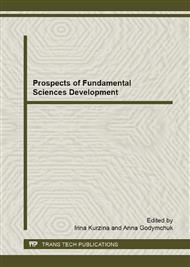[1]
M.S. Mauter, M. Elimelech, Environmental applications of carbon-based nanomaterials, Environ. Sci. Technol. 42 (2008) 5843-5859.
DOI: 10.1021/es8006904
Google Scholar
[2]
S.R. Mousavi, M. Rezaei, Nanotechnology in agriculture and food production, J. Appl. Env. Biol. Sci. 10 (2011) 414-419.
Google Scholar
[3]
G. Jia,H. Wang,L. Yan, X. Wang,R. Pei,T. Yan,Y. Zhao, X. Guo, Cytotoxicity of carbon nanomaterials: single-wall nanotube, multi-wall nanotube, and fullerene, Environ. Sci. Technol. 39 (2005) 1378-1383.
DOI: 10.1021/es048729l
Google Scholar
[4]
A. Shvedova, V. Castranova, E. Kisin, D. Schwegler-Berry, A. Murray, V. Gandelsman, A. Maynard, P. Baron, Exposureto carbon nanotube material: assessment of nanotube cytotoxicity using human keratinocyte cells, J. Tox. Environ. Health. 66 (2003).
DOI: 10.1080/713853956
Google Scholar
[5]
C. Lin, B. Fugetsu, Y. Su, F. Watari, Studies on toxicity of multi-walled carbon nanotubes on Arabidopsis T87 suspension cells, J. Hazard. Mater. 170 (2009) 578-583.
DOI: 10.1016/j.jhazmat.2009.05.025
Google Scholar
[6]
M. Ghosh, A. Chakraborty, M. Bandyopadhyay, A. Mukherjee, Multi-walled carbon nanotubes (MWCNT): Induction of DNA damage in plant and mammalian cells, J. Hazard. Mater. 197 (2011) 327-336.
DOI: 10.1016/j.jhazmat.2011.09.090
Google Scholar
[7]
M.V. Khodakovskaya, K. de Silva, A. S. Biris, E. Dervishi, H. Villagarcia, Carbon nanotubes induce growth enhancement of tobacco cells, ACS Nano. 6 (2012) 2128 – 2135.
DOI: 10.1021/nn204643g
Google Scholar
[8]
X. Tan, C. Lin, B. Fugetsu, Studies on toxicity of multi-walled carbon nanotubes on suspension rice cells, Carbon. 47 (2009) 3479-3487.
DOI: 10.1016/j.carbon.2009.08.018
Google Scholar
[9]
F. Schwab, T. D. Bucheli, L.P. Lukhele, A. Magrez, B. Nowack, L. Sigg, K. Knauer, Are carbon nanotube effects on green algae caused by shading and agglomeration?Environ. Sci. Technol. 45 (2011) 6136-6144.
DOI: 10.1021/es200506b
Google Scholar
[10]
Z. Long,J. Ji,K. Yang, D. Lin, F. Wu, Systematic and quantitative investigation of the mechanism of carbon nanotubes' toxicity toward algae, Environ. Sci. Technol. 46 (2012) 8458-8466.
DOI: 10.1021/es301802g
Google Scholar
[11]
H. Chung, Y. Son, T. Yoon, S. Kim, W. Kim, The effect of multi-walled carbon nanotubes on soil microbial activity, Ecotoxicology and Environ. Safety. 74 (2011) 569–575.
DOI: 10.1016/j.ecoenv.2011.01.004
Google Scholar
[12]
M. V. Khodakovskaya, B. Kim, J. N. Kim, M. Alimohammadi, E. Dervishi, T. Mustafa, C.E. Cernigla, Carbon nanotubes as plant growth regulators: effects on tomato growth, reproductive system, and soil microbial community, Small. 9 (2013) 115-123.
DOI: 10.1002/smll.201201225
Google Scholar
[13]
X. Wang, X. Liu, H. Han, Evaluation of antibacterial effects of carbon nanomaterials against copper-resistant Ralstoniasolanacearum, Colloid. Surface. B: Biointerfaces. 103 (2013) 136-142.
DOI: 10.1016/j.colsurfb.2012.09.044
Google Scholar
[14]
M. Khodakovskaya, E. Dervishi, M. Mahmood, Y. Xu, Z. Li, F. Watanabe, A. S. Biris, Carbon nanotubes are able to penetrate plant seed coat and dramatically affect seed germination and plant growth, ACS Nano. 3 (2009) 3221-3227.
DOI: 10.1021/nn900887m
Google Scholar
[15]
S. Tripathi, S.K. Sonkar, S. Sarkar, Growth stimulation of gram (Cicerarietinum) plant by water soluble carbon nanotubes, Nanoscale. 3 (2011) 1176-1181.
DOI: 10.1039/c0nr00722f
Google Scholar
[16]
A. Mondal, R. Basu, S. Das, P. Nandy, Beneficial role of carbon nanotubes on mustard plant growth: An agricultural prospect, J. Nanopart. Res. 13 (2011) 4519-4528.
DOI: 10.1007/s11051-011-0406-z
Google Scholar
[17]
X. Wang, H. Han, X. Liu, X. Gu, K. Chen, D. Lu, Multi-walled carbon nanotubes can enhance root elongation of wheat (Triticumaestivum) plants, J. Nanopart. Res. 14 (2012) 841.
DOI: 10.1007/s11051-012-0841-5
Google Scholar
[18]
G. Ghodake, Y. D. Seo, D. Park, D.S. Lee, Phytotoxicity of carbon nanotubes assessed by brassica juncea and phaseolusmungo, J. of Nanoelectron. Optoelectron. 5 (2010) 157-160.
Google Scholar
[19]
P. Begum, R. Ikhtiari, B. Fugetsu, M. Matsuoka, T. Akasaka, F. Watari, Phytotoxicity of multi-walled carbon nanotubes assessed by selected plant species in the seedling stage, Appl. Surface Sci. 262 (2012) 120-124.
DOI: 10.1016/j.apsusc.2012.03.028
Google Scholar
[20]
P. Begum, B. Fugetsu, Phytotoxicity of multi-walled carbon nanotubes on red spinach (Amaranthus tricolor L) and the role of ascorbic acid as an antioxidant, J. Hazard. Mater. 243 (2012) 212-222.
DOI: 10.1016/j.jhazmat.2012.10.025
Google Scholar
[21]
E.A. Smirnova, A.A. Gusev, O.N. Zaitseva, E.M. Lazareva, G.E. Onishchenko, E.V. Kuznetsova, A.G. Tkachev, A.V. Feofanov, M.P. Kirpichnikov, Carbon nanotubes enter the cells and stimulate sprouts of esparcet Onobrychis arenaria (Kit. ). Ser., Acta naturae. 3 (2011).
DOI: 10.32607/20758251-2011-3-1-99-106
Google Scholar


